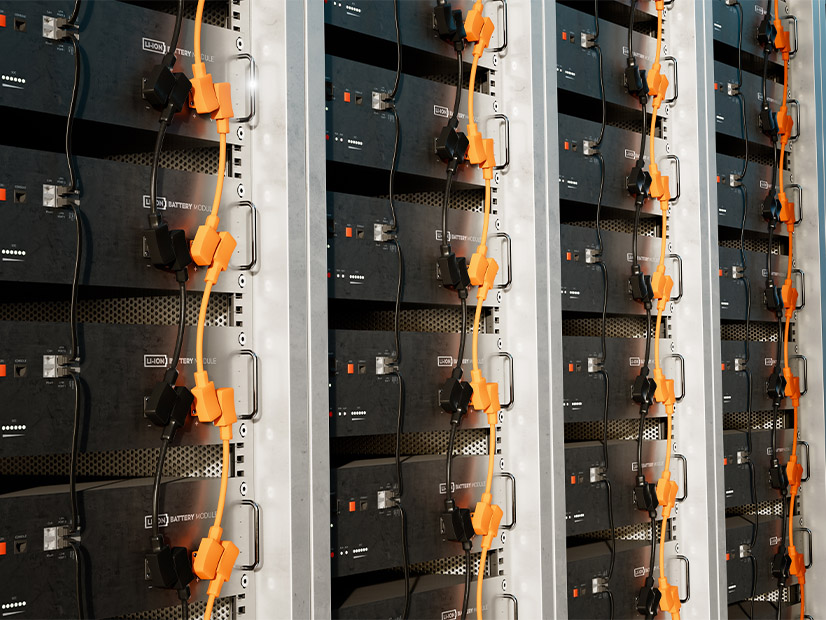
A task force formed in the wake of significant fires at three grid-scale battery energy storage systems has recommended new safety protocols for the facilities in New York state.
The 15 draft recommendations published Feb. 6 are open now for comment by the public and industry stakeholders. The final versions will be considered by the New York State Code Council for inclusion in the Fire Code of New York State and in other fire safety standards that apply to energy storage facilities.
The three fires came in two months in mid-2023, each larger than the one before. Fires in lithium-ion battery energy storage systems (BESS) are hard to extinguish and can emit toxic smoke, but an extensive review found no sign of environmental damage or public health risks in the aftermath of these three. Nor were any injuries reported. (See Analysis Shows No Contamination from NY BESS Fires.)
Public perception was perhaps the biggest casualty of the fires, becoming a friction point for New York’s clean energy ambitions, which will require many gigawatt-hours of installed storage to backstop intermittent renewables. (See Battery Storage Developers Bump Against Perception of Risk.)
Numerous municipalities statewide proposed or enacted BESS moratoria as 2023 went on.
After the third fire, Gov. Kathy Hochul (D) formed the Inter-Agency Fire Safety Working Group to examine the incidents and BESS safety standards. In late December, the group issued its initial analysis of the toxic effects of the fires.
The fire code recommendations announced Feb. 6 were the next step. They’re intended to apply to lithium-ion grid-scale BESS exceeding 600 kWh of capacity.
The working group’s continuing efforts include negotiations with the battery manufacturers and utilities to obtain root cause analysis reports for the three fires and perform inspections of all operational BESS above 300 kW in New York.
BESS safety industry experts are part of the working group. The BESS industry itself is not. Its input will come now, during comment on the draft recommendations.
The New York Battery and Energy Storage Technology Consortium told NetZero Insider via email: “NY-BEST is pleased that the State Inter-Agency Battery Safety Working Group has released its thoughtful draft recommendations and is soliciting feedback and additional input from industry subject matter experts. The energy storage industry appreciates the significant efforts of the state’s working group and we share the state’s interest in ensuring that battery energy storage is deployed safely throughout the state. We look forward to leveraging our expertise to assist the state in developing final recommendations that achieve our shared goal of making New York a leader in safe deployment of battery energy storage.”
The Alliance for Clean Energy New York also was not ready to comment Feb, 6on the recommendations themselves. It said: “In the coming days, we plan to review closely the 15 draft recommendations proposed by the working group and look forward to submitting comments and working with the New York State Code Council to ensure that the installation and operation of BESS facilities continues in a safe manner.”
The Recommendations
The Working Group noted in conclusion that the most critical issues it identified could be addressed by better enforcement and adherence to the existing code.
It offered the 15 recommendations as ways to improve the regulatory framework for BESS in New York. They are:
-
- Require industry-funded independent peer reviews for all projects.
- Expand the requirement for explosion control to include BESS cabinets in addition to rooms, areas, and walk-in units; additionally, provide design requirements or language for what constitutes a “passable” system.
- Require that qualified personnel are available for dispatch within 15 minutes and able to arrive on scene within four hours to provide support to local emergency responders.
- Extend safety signage requirements beyond the BESS unit itself to include perimeter fences or security barriers and include a map of the site, BESS enclosures and associated equipment.
- Update the Fire Code to ensure that Battery Management System data is monitored by a 24/7 staffed Network Operations Center. Critical failure notifications should be immediately communicated to the site owner/operator to take corrective actions as necessary.
- Update the Fire Code to incorporate requirements for closed-circuit television systems, specifying their intended use as both a continuous monitoring tool and a post-event analysis resource.
- Remove the Fire Code exemption for BESS projects owned or operated by electrical utilities to ensure that all projects comply with the Fire Code.
- Include a requirement for an Emergency Response Plan and annual local first responder training for every BESS installation.
- Include a Fire Code requirement for monitoring of fire detection systems by a central station service alarm system to ensure timely, proper notification to the local fire department in the event of a fire alarm.
- Mandate the installation of fire stops for all BESS enclosure penetrations to prevent the propagation of fires from one BESS unit to another through these pathways.
- Introduce a new provision in the Fire Code mandating industry-funded special inspections for BESS installations to ensure thorough safety and compliance.
- Include “cabinets” in all Fire Code requirements that pertain to rooms, areas or walk-in units, except for fire suppression requirements, as they may be inappropriate for cabinets.
- The WG concluded that the Fire Code may not be the appropriate place to require a Root Cause Analysis.
- Establish guidance for water supply, including whether water is appropriate for different technologies, in an emergency response to a BESS fire and determining if more specific requirements are necessary.
- Recommend that the Code Council have further discussions around clearance distances of oil-insulated transformers from BESS.
